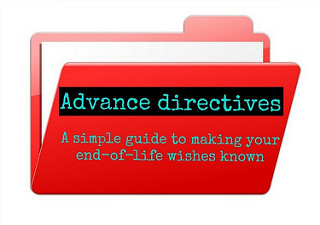What is an advance directive and how do you get one?
It’s the topic we don’t want to think about or even discuss, but is critical that we put to paper: What we want to happen in a medical emergency if we can’t express our own wishes.
An advance directive is a legal document that outlines your wishes for end-of-life medical treatment and care to inform health care professionals and loved ones. Here’s how to finally get started putting together your own advance directive or assisting a loved one, in simple, straight-forward steps.
Step 1: Admit you need one
Everyone over 18 years of age should have an advance directive, says
Tracy Christner, a certified advance care planning facilitator and instructor.
“Having a plan that makes your health care wishes known is the best way to ensure you get the treatment you want,” says Christner. “It also helps your loved ones make tough choices without having to worry whether they are doing the right thing for you.”
Step 2: Learn the components
It’s easy to get caught up in the legalese, but an advance directive is nearly self explanatory. It
directs your loved ones and healthcare providers about what to do
in advance of an end-of-life situation.
There are two types of advance directives and it is important to have both.
- A living will expresses end-of-life medical preferences
- A healthcare power of attorney designates a spokesperson (“health proxy”) who will be responsible for making health-related decisions on your behalf
Step 3: Seek out the paperwork
This is state-dependent. Contact your local hospital,
eldercare agency, or
state website. Or,
download free forms on the AARP’s website. Don’t get lost in the sea of options—pick one, make sure it meets your state’s legal requirements, and get started.
“If you spend a significant amount of time in more than one state and they don’t have reciprocity in honoring each others’ directives, you should complete one for each state,” says
Dr. John Saroyan, medical director for BAYADA Hospice.
Step 4: Determine your wishes
Five things to consider for your living will:
CPR, breathing tubes, feeding tubes, dialysis and organ donation.
Don’t get discouraged. If you aren’t sure how you feel about any specific aspect, focus on the big picture.
“Most healthcare providers would agree we want people to feel as well as they can for as long as possible,” says
Sabrina Mikan, PhD, RN, ACNS-BC, Director of Supportive Care Programs for Texas Oncology. “Improving a person’s quality of life and well being in any time of illness should be the goal of care.”
For your healthcare proxy, designate a primary person and an alternate. And make sure these people understand your wishes and are comfortable carrying them out.
“Choosing someone local is best since
decisions may need to be made quickly,” says Christner.
Step 5: Discuss your wishes
Talk to family, friends and
healthcare providers.
“Be sure to include anyone who may play a part in your care,” says Christner. “Families can be torn apart caring for someone they love if they do not know their wishes ahead of time. While
it is never easy to start this conversation, it is a lot easier than the consequences of avoiding it.”
Step 6: Get the signatures
Depending on your state, you may need an attorney’s signature. Most states require signatures in the presence of witnesses, or a notary, in order for the directive to be legally valid.
Step 7: Keep the original copy
Put it in an obvious, unsecured place
. The most common mistake people make is completing an advance directive and then hiding it away, says Christner. “Advance Directives need to be accessible in order to be used.”
Step 8: Distribute to key people
Give copies of your advance directive to your primary and alternate healthcare proxies, and your primary care provider.
Step 9: Make its presence known
Note that you have an advance directive on an insurance card or medication list and keep these in your wallet. You can also flag its location in the letter of instruction included in your will.
Step 10: Reevaluate periodically
Healthcare desires change, so keep your advance directive updated. One way to stay on top of this is to upload your document to a website like
US Living Will, which prompts users annually to update their information.
Watch UPMC’s webinar on advance directives here.

